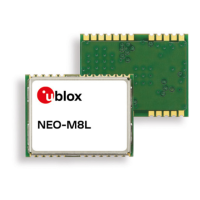
Do you have a question about the u-blox M8 Series and is the answer not in the manual?
| Update Rate | Up to 10 Hz |
|---|---|
| Supply Voltage | 2.7 V to 3.6 V |
| GNSS | GPS, GLONASS, BeiDou, Galileo, QZSS |
| Sensitivity | Tracking & navigation: -167 dBm, Cold start: -148 dBm |
| Operating Temperature | -40°C to +85°C |
| Assisted Start | AssistNow Online and AssistNow Offline services |
| Interface | UART, SPI, DDC (I2C), USB |
| Receiver Type | 72-channel |
Provides a general overview of the NEO-M8L modules, highlighting their 6-axis sensors and concurrent GNSS engine.
Details on modifying configuration settings using UBX protocol messages and saving them in SQI flash.
Explains the three power supply pins (VCC, V_BCKP, VDD_USB) for NEO-M8L modules and their functions.
Describes the main supply voltage (VCC) and its requirement to support peak power and internal capacitor charging.
Details the backup supply voltage (V_BCKP) for the RTC and BBR, crucial for cold starts and GNSS performance.
Covers the VDD_USB pin for the USB interface and its connection requirements, including grounding when not in use.
Explains the VCC_RF pin for supplying active antennas or external LNAs, including filtering.
Introduces the available interfaces: UART, USB, DDC, and SPI, and their respective functionalities.
Details the UART interface, its serial characteristics, and voltage levels for communication.
Describes the USB interface capabilities, including speed and required external components for connection.
Explains the I2C-compatible Display Data Channel (DDC) interface for serial communication with host CPUs.
Discusses the SPI interface, its potential conflicts with UART/DDC, and how to enable it via D_SEL.
Details the TX Ready signal, which indicates data transmission availability and its configuration options.
Covers the various Input/Output pins of the NEO-M8L module, detailing their functions and electrical characteristics.
Explains the RESET_N pin for hardware reset, noting its impact on power consumption and the RTC.
Describes the WHEELTICK input for speed pulse information, including edge detection and pulse width requirements.
Details the FWD input for indicating vehicle direction, including polarity initialization and manual setting.
Explains the D_SEL pin used to select between UART/DDC and SPI interfaces.
Describes the LNA_EN pin for controlling external LNAs to optimize power consumption.
Covers the TIMEPULSE output, providing configurable time pulse signals synchronized with GPS or UTC time.
Discusses EMI effects on I/O lines and offers solutions like using resistors or ferrite beads for noise reduction.
Provides a detailed description of each pin on the NEO-M8L module, including their name, I/O type, and function.
Lists previous and new pin names for NEO-M8L modules, highlighting changes in naming conventions.
Illustrates a minimal hardware design for a NEO-M8L GNSS receiver, showing essential components and connections.
Offers recommendations for the PCB footprint and paste mask for NEO-M8L modules, focusing on solder joint quality.
Covers antenna design considerations for the NEO-M8L, focusing on passive and active antenna setups.
Details the design of passive antenna systems for NEO-M8L, including layout and RF section considerations.
Describes the design requirements for active antennas, including power supply and RF connections for NEO-M8L.
Explains how the NEO-M8L utilizes its internal sensors for automotive dead reckoning (ADR) and speed/direction input.
Discusses sensor calibration for ADR, emphasizing its importance for navigation quality and ongoing refinement.
Briefly mentions software migration aspects related to the ADR functionality of NEO-M8L modules.
Provides guidelines for handling, packaging, shipping, and storing NEO-M8L modules, including MSL information.
Details recommended soldering processes, paste, and reflow profiles for NEO-M8L modules.
Outlines essential precautions for Electrostatic Discharge (ESD), Electrical Overstress (EOS), and Electromagnetic Interference (EMI).
Covers general safety precautions required for automotive grade NEO-M8L modules, including SELV circuits.
Discusses achieving isolation between GNSS and cellular antennas in multi-antenna designs.
Addresses methods to improve interference immunity against in-band and out-band signals.
Explains out-band interference sources and measures to mitigate them for GNSS receivers.
Lists recommended electronic components, including diodes, SAW filters, LNAs, and capacitors for use with NEO-M8L.
Presents a list of recommended antennas suitable for use with NEO-M8L modules, specifying manufacturer and specifications.
Provides a list of related documents and resources for further information on NEO-M8L and u-blox products.
Details the revision history of the NEO-M8L hardware integration manual, including dates and changes made.
Lists contact information for u-blox offices worldwide for support and inquiries.
